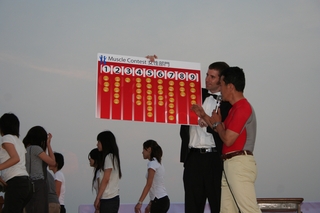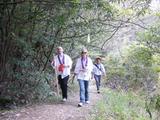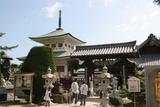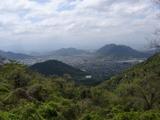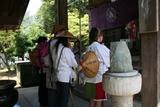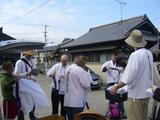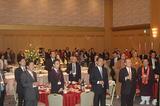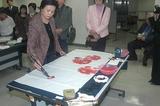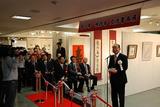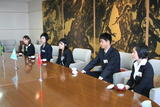On July 25, 2009, Gert Johannes Grobler, the Ambassador to Japan from South Africa, paid a courtesy visit to Governor Manabe. The conversations revolving around the Setouchi International Art Festival 2010 (to be held next year in Kagawa) and the 2010 World Cup (to be held in South Africa) were very lively, and it was a lot of fun to translate.
2009 Archive
这天我们出发时天气有些阴间多云,但没多久太阳就出来了。由于天气变得非常晴朗,走到陡峭的地方时,会感到有一些热。此次遍路旅行让所有的参加者都度过了一段难忘的时光,并且还参观了许多美丽的地方。我们是在听完一些关于四国88处寺庙遍路旅行的介绍后,从国分寺出发的。
沿途我们还受到了广播电台和报纸记者的采访。在离开国分寺之前,我们接受了欧塞塔服务(一种由当地老百姓给参加88所寺庙遍路旅行体验的人提供的一种服务)。由于几天前下过雨,有些路段比较泥泞,但我们都不在乎,因为沿途的风景非常美。
我们步行了18公里,参观了国分寺、白峰寺和根香寺,并且在根香寺还听了该寺助理主持的演讲。此行结束的时候,大家都感到非常满意。
为欢迎陕西省友好代表团到访香川举办祝贺宴会。
诸位日中书画家挥毫泼墨,各展才艺。
在I-PAL香川通过深受两国人民欢迎的书法,进行了文化交流。并且,祈愿两县省进一步的交流和发展,栽种了香川县树橄榄树。
The ambassador of the Republic of South Africa visited Kagawa and made a courtesy visit with the Governor.
4月14日(星期二),15日(星期三)以陕西省人民代表大会常务委员会主任赵乐际为团长的友好代表团一行35人拜访了知事・县议会议长,出席书画交流展,植树纪念仪式等活动,加深了双方的友谊。
The Overseas Technical Trainees Have a Courtesy Visit with the Vice Governor of Kagawa Prefecture.
香川县海外技术研修员向副知事作自我介绍。
Six students at Elberton High School and a chaperone came to Kagawa on a short term homestay program, which began in 1985, and paid a courtesy visit to the Governor. This is the 24th reception of Elberton high school students.
Yoori Lee, who was invited from Canada to participate in the JET Programme for the purpose of promoting international exchange and foreign language education in Kagawa Prefecture, visited the Governor for a farewell ceremony. The Governor presented a letter of appreciation to her.
In order to promote Kagawa's Movie Attraction Campaign, a Bond Night Party was held on Naoshima Island on July 4th. As Kagawa's James Bond, I had the privilege of hosting the first half of the event. During the main event, the Muscle Contest, male contestants did their best in such events as the push-up contest, and female contestants tried to win at events like the table-cloth pulling contest. A lot of people showed up to enjoy the party, and the festivities lasted until the final high-speed boat headed back to Takamatsu at the end of the night.
ユネスコの世界遺産登録を目標にしている外国人のための四国88ヶ所遍路体験に行ってきました。まず、白衣などの遍路の衣装を着て、参拝の仕方やお寺の説明をしてもらいました。その後早速、おもてなしのお接待もあっておいしいおはぎをいただきました。出発する前からうれしい~~☆しかし、うれしいのも一瞬。普通はあまり運動しない私ですから、時々息が止まりそうな所もありました。88ヶ所全体に比べるとほんの少しの距離でしたが、今回の遍路体験を通して、今まで見たことない田舎の風景、きれいな花、気持ちいい風を感じながら、また新しい香川が発見できたと思います。皆さんもお遍路で新しい香川の発見いかがですか?
First I would like to say thank you to the event organisers and participants that put so much into it to make an enjoyable and rewarding day. I am very glad to have been able to participate in the experience and can thoroughly recommend that stretch of the Henro as a beautiful, scenic and peaceful part that contrasts with the more urban sections.
The road from Nagaoji to Okuboji seems to have elements that represent much of Kagawa. The busy roads around the Kotoden station in Nagao with the tour buses, taxis and old folk give way to more open small holdings with their seasonal crops, fruit trees compressed gardens and complex dwellings. These in turn give way, as the road rises towards the green mountains in the south, to larger fields and larger, older houses with their "tsuchikabe" walls encircling large gardens and courtyards. As the roads starts to climb higher the valley sides begin to narrow and their height becomes appreciable. Before reaching the scenic lunch stop at the Maeyama Dam our guide Mr Katagiri pointed out several roadside stone markers which reinforced the connection of the modern asphalt road with the history of the Henro tradition. More modern markers of tape and plastic abound but these carved markers are somehow more reassuring.
Leaving the Dam behind the path soon leaves the broad Prefectural road and makes a beeline for Mount Nyoutai as the path leaves the asphalt and becomes steeper and narrower, winding up through the forest, at times following secluded streams or skirting isolated rice fields. Travelling in a group we perhaps did not really notice the silence of the forest except at brief pauses before tackling the next steep stretch.
The track then ascends Mount Nyoutai, the trees and under growth change with the altitude, the translucent deciduous foliage mixing with sporadic bamboo stands and towering cedars.
Tantalising glimpses of the valley behind and the Sanuki plain beyond are satisfying proof of one's progress from urban to the natural in space of a few hours. Once we finally reached the lookout on the ridge near the top of Mount Nyoutai, the stunning view was great reward for the efforts of the climb. The subsequent descent to Okuboji Temple down well maintained stairs is much easier and the roofs of the temple buildings quickly came into view. The serene destination was a welcoming sight for the weary part time pilgrims and must be even more so for those dedicated individuals who have spent months walking and climbing to complete the entire 88 Temple route. Personally this is one of the sections I will do again, and take more time to enjoy the forests and ever changing views.
I woke up very early and hurried to catch the train. I was still tired and not sure if I was up for what was ahead. My grandmother had passed away just a few days before and I was still trying to deal with this. I finally started to get excited once I met up with other friends who were ready for the challenge.
Once we got to Nagao Temple we were given everything we needed, the walking staff, the pilgrim jacket and the conical hat. This was my first time to ever use these and I started to feel more like a pilgrim. We were then taught how to behave and what to do at a temple. A very kind monk explained about the buildings and about history of Kukai, the first pilgrim.
As we started to leave Nagao Temple we were given mochi as a snack. This is a testament to the kindness Japan shows to pilgrims. I am always amazed when I hear of these stories. Most pilgrims travel with very few belongings and little money. Complete strangers will offer money and try to help pilgrims along their journey. Essentially, these strangers are becoming closer to Kukai through doing this.
The walk was 16 kilometers and a majority of it was through woods and up and down mountains. It was breathtakingly beautiful. As our trail wound around creeks and scenic cliffs, we all had to slow a bit to fully appreciate our surroundings. I noticed that when we had started we were all very talkative yet as we continued through the mountains, we became more absorbed with the nature.
I've been to several temples, sometimes by car and sometimes on foot. Yet this was my first organized ohenro walk and definitely my most challenging thus far. Towards the end I was wondering if I had the energy to keep going. Yet, being with a group of people and thinking about all the others who had gone before me gave me the will to keep going. I started the trip with a heavy heart and found it a little lighter at the end. There's something magical about a pilgrimage that can unite so many diverse people with a common goal. Religious beliefs do not matter. This pilgrimage is about becoming closer to Kukai and becoming a better person. It challenges you both physically and mentally. I felt that I not only bonded with all the people I journeyed with on this trip, but with others who had come before and others would come later.
Though I may never have the opportunity to complete the entire pilgrimage to the 88 temples of Shikoku, I wish luck to anyone who sets out on the journey. Even a visit to only a few temples along the pilgrimage is a worthwhile experience for anyone seeking a greater understanding of Japan, Buddhism and the culture of hospitality on Shikoku.
Journey
A days trek commences at a sacred temple
Clouds overhead, white but ready to rain.
What's in store for us from here?
We traipse along urban sidewalks
clad in white robes and straw hats
wielding sticks and shadowed by chiming bells
Pass farmers tending their fields
Pass a dam and a busy rest center
Monkeys spotted resting by a stream, onlookers excited
A hawk circles overhead, overlooked
Into the forested mountains, along brooks and shallow pools,
scrambling over rocks, hauling our bodies up
Fatigued muscles aching, burning, knees jittering
Refreshing raindrops sneak through the canopy overhead.
Mesmerizing views of the valley below.
Our reward for a days trek?
A quick descent back to yet another sacred place.
Respects paid, prayers left, and we each go our separate ways.
What's in store for us from here?
Written about May 16th, 2009 Nagao-ji to Okubo-ji Henro experience.
A Henro Hangover: A Short Reflection
"Aunnie sensei, are you O.K.?" a few students asked me on our way up a flight of stairs early Monday morning.
Even though I responded with an energetic, "元気ですよ!" I am sure my お祖母さん hobbling revealed another story. When I finally admitted to my students (after an intense inquisition I might add) that henroing was the cause of my aches and pains, a few couldn't help but laugh. "Ohenrosan?" "Hoooooma?!" I can't blame them because the first thing that probably came to their minds is what comes to most of ours: a recent retiree, erratically holding his or herself up with a walking stick, being conveniently driven around Shikoku on a bus tour. So, how could an activity symbolized by recent retirees possibly cause what appears to be a henro hangover in a twenty-two year old?
Well, let me tell you. We trekked it. We didn't walk, we didn't hike, hot damn we trekked it. Sure, it sounds easy enough, and it was until we ran into mountains. Huuuuuge mountains (especially when you're looking to catch a 4 o'clock bus)! Okay, yeah there were plenty of trails in these mountains, but they were what I would call "unique." By this, and in no way am I kidding, I mean they were the most ridiculously planned trails I have ever seen. Sure, I may not be an experienced climber, but still these trails were reminiscent of an awful rollercoaster ride (you know the kind, where even the most daredevil one of the group look at you afterwards and say "Never again."). As if these incessant and insanely-steep ups and downs weren't enough, there was a point in our venture where the trail stopped. That's right. No trail--just rocks. At this moment I just started laughing and bellowed into the wilderness, "For realz, Kukai?! Are you serious?!!" What solidified my pathetic display of physical vigor, however, was having people twice my age bounce around like this was an actual walk in the park. They had to be part mountain goat, I swear!
Although my complaining proves otherwise, I wouldn't have traded the physical exhaustion or embarrassment for anything else that Saturday afternoon. I had an absolute ball. Yes, by the end, I was drenched in sweat, my legs were shaking, and it was getting difficult to feel my feet, but that's what it's all about. As I stated in my previous writing, henroing is what you make of it. There are no set standards for doing ohenrosan (i.e. health, spirituality, history, etc.), so even if traveling together, no two henros share the same journey. This is exactly what makes this experience so unique, and why I feel the 88 Temples would be a valued addition to the UNESCO's World Heritage Sites. Unlike Himeji-jo or Itsukushima Shinto Shrine, where you pay an entrance fee, walk around, look at the artifacts, and take pictures, the 88 Temples gives people an opportunity to actively engage with Japan in a very personal way. Shikoku's 88 Temples gives tourists and non-tourists alike an opportunity to put down the camera, go beyond the glass casings, and surrounded themselves with the Japanese culture in a manner that is completely distinctive to the ohenrosan experience.
Considering Historical Accuracy: The Shikoku Temple Pilgrimage as a World Heritage Site
Since around the late 17th century, the Japanese island of Shikoku has hosted a temple pilgrimage known to the locals as the hachijyuuhachikashou, so named after the 88-temples that make up the course. Put briefly, there's nothing amateur about the governance: proper rituals are codified, correct uniforms are encouraged, and an order has been given to which temples should be visited first and last. Travelers often carry the proof of their travels in ornate books that upon visitation of any temple are stamped and marked in calligraphy. Paved roads clearly point the way to pilgrimage temples, and well-worn paths meander through the countryside for those that prefer to make the journey by foot. Temples often contain engraved stones remembering those that have donated money or work. In this sense, it is no doubt that the Shikoku Temple Pilgrimage is a cultural entity. To be from Shikoku is to be related, at least tangentially, to the roads and clothes and traditions that mark the pilgrimage.
A prominent feature along the course of temples is the image of the monk Kukai, posthumously named Kobo Daishi. It might be said that Kukai's role is so prevalent that it can never be divorced from the pilgrimage. Local legend maintains that Kukai visited each of the temples, either for a short while or a long time, doing something significant as solving droughts and saving crops or as "insignificant" as praying. Often, Kukai is credited for founding the temples and directing them for short periods. Many of the more fantastic stories--such as Kukai throwing himself from a cliff and being saved by the hand of Buddha--have been accepted as tall tales and relegated to the entertaining mythology of the pilgrimage. Nonetheless, the image and persona of Kukai is pervasive. Pilgrims are encouraged to dress in costumes that bear the image and words attributed to Kukai. The walking staff carries a mantra, "We go the same way," reminding the traveler that they are going in Kukai's footsteps, and that his spirit guards the path. The traveler is to meditate upon this and Kukai's teachings. It is safe to say then, that this cultural entity that is the Shikoku Temple Pilgrimage is meant to be a reflection of Kukai's past travels and mediations.
There is amassed interest in making efforts to include the Shikoku Temple Pilgrimage among the UNESCO World Heritage Sites. It should be considered, then, the cultural importance of the pilgrimage. How long has it been a valuable cultural asset? In brief, it features 88 temples whose locations (although usually not the buildings) have been in place since the mid-9th Century. The pilgrimage itself has been codified for almost 300 years, and draws hundreds of thousands of people each year now. The temples are associated with religion now and have an acting monk on premise, and have often been associated with political actors in the past. On these grounds alone, the temples of Shikoku could possibly qualify for inclusion among other World Heritage Sites. However, there stands, in this author's opinion, a major obstacle in the way of such acceptance.
That obstacle is the reliance upon the Kukai mythology. That is to say, the Kukai mythology goes far beyond stories that the monk survived falls off cliffs. It is the very fact that there is no evidence Kukai visited the temples. It is true that the monk was born in Zentsu-ji, in Kagawa Prefecture. Beyond that, however, there is only word from legend. Even in his own voluminous writings, there is scarcely a mention of any other temple in Shikoku.
It might be argued that this is an instance where "word-of-mouth" history triumphs over documented history, in that local legends hold more truth than does the written word. At this point, we must consider, then, a few suppositions of our own. Established literature holds that the only possible time Kukai could have done any such journey was in his mid-to-late twenties, when it is thought he abandoned university to become a wandering ascetic. To be brief, at this time Kukai had just discovered Buddhism, and had yet to develop his own model of esoteric Buddhism for which he would be revered. That development only came to be after a trip to China in his early 30's. Following his return to Japan in his mid-thirties, Kukai's life is well-documented, as he became a servant of the Emperor and later went to work on establishing the monastic center at Mount Koya.
If it is true, then, that Kukai journeyed the countryside of Shikoku in his mid-twenties and never wrote about it, then he also did so when he was not a priest. He would have had a basic grounding in Buddhism, but his true education and philosophical development began many years later during his extended stay in China. Even if the leeway is given that Kukai managed to visit the temples, it must be admitted that he did so as a man of no great influence or distinction. It is difficult to lend credence to people building temples on mountaintops and in thick groves at the command of a neophyte who had yet to establish himself as anything more than an ascetic.
Extant literature doesn't help in clarifying the origins of the temple pilgrimage. They tend to do one of two things: 1) refer to the canonical belief that Kukai visited every temple and did the journey along the paths that still exist today, or 2) briefly mention Kukai's real life and then admit scarce details exist, but nonetheless trust the word of the locals that Kukai made at least some of the journey. While an easy way out, this cannot be the way of accuracy. When discussing inclusion into a group like World Heritage Sites, there is simply no room for suppositions to become the foundation of truth.
In this author's opinion, what is necessary for the temple pilgrimage's consideration as a World Heritage Site is one of two things: 1) extraction of the Kukai mythology both from practice and canonical accounts of the temple pilgrimage, or 2) or complete admission and advertisement of the mythology. The first option is practically impossible. As this essay established at the beginning, the image of Kukai is inseparable from the temple pilgrimage. To remove it would to remove, literally, the spirit from the journey. People would protest until the end of their days, because they have been brought up to believe that Kukai made this trip. It is simply too disheartening a path to follow.
The second option, then, is what should be followed. It must be admitted that this pilgrimage is done for a number of reasons: exercise, camaraderie, cultural investigation, personal challenge. It is also done because, for better or worse, a mythology and extensive marketing has developed around the figure of Kukai. The costumes, the signs, the temples with statues, are all economically tied to the image of Kukai. It must be advertised to the World Heritage commission that the Shikoku Temple Pilgrimage is many things: a cultural entity, a marketing entity, a mythological entity, a philosophical entity. Above all, it is an entity the people of Shikoku will fight direly to protect.
That is, then, exactly the importance of the temple pilgrimage to the people of Shikoku. People created the pilgrimage, and gave it meaning, and continue to believe and practice a tradition handed down to them over time. The Kukai mythology simply cannot be divorced from the pilgrimage, so it must be admitted for what it is.
Books upon books and essays upon essays have been written on the beauty of traveling the Shikoku countryside while on the pilgrimage. It is more important, however, to consider the true history behind the pilgrimage, because this will be what the UNESCO council will consider. There are many places in the world with beautiful trees, tall hills, and old buildings. There are, however, only so many places in the world where locals and foreigners alike traverse the beautiful terrain in costumes while chanting and contemplating philosophy. It is this action--the very act of being a pilgrim along the way to ancient temples--that should be considered as a World Heritage.
Henro
For the past two years I have lived in Zentsuji, just minutes from where Kukai was born. I frequently visit the temple and hike the mountains behind. While climbing these mountains I think of Kukai as a boy, before he founded the Shingon sect and became Kukai, and wonder what he thought about as he walked through this same forest.
Arriving at Nagao station I still had Kukai on my mind, and the saying that all henro wear on their white jackets and on their straw hats: 同行二人. While walking through the mountains surrounding Zentsuji I really felt that Kukai was walking with me. Now, as we left the station dressed as real live henro, I got the same sense that Kukai was walking beside all of us, despite all the changes to the surrounding town that has grown up around the temple in the past 1,000 years. Even though very little would have been recognizable to Kukai if he were to set out on the pilgrimage today, there are still reminders throughout the countryside. Every now and again we would pass a small stone pillar carved with directions to the next shrine or temple, no doubt a welcoming sight before there were paved roads and GPS.
After a couple hours of walking through the town and deeper and deeper into true Japanese countryside, we left pavement completely behind to start our hike up the mountain to Okuboji Temple. While the scenery through this area was stunning, I would have preferred Kukai to carry me rather than walk alongside me. After an hour of walking uphill, with our henro bells jangling to the creek's tinkling, I felt in awe of the true henro of the past who not only walk up this mountain, but also continue on for another 1,200 kilometers through mountains that are just as high and challenging. But once I neared the top I could view the Sanuki plain stretching below, making my aching leg muscles feel not so bad. With just a little more push we arrived at Okuboji Temple, and I felt glad that I had pushed myself up the mountain, like I had accomplished something. I prayed first at the main temple, then to Kukai, thanking him for keeping me company on my struggle up the mountain. Then I found the nearest bench and waited with a well-earned matcha ice cream for the bus to take us back to Nagao station.
Looking back, even more than the nature or the temples themselves, I found that the people are what make the henro experience unique. All along the path there was a sense of community, not only from your fellow henro, but from the families living along the henromichi. While some are willing to give lodging to a traveling henro, others food or money, they all seemed to at least give a warm, hearty smile and an air of "gambatte!" You aren't just walking with Kukai, but with everyone you meet along the way.
Menace and Mediation:
An American account of a one-day pilgrimage
Most people stashed their bells away in their pockets or tucked them up under the strap of a sports bra to put an end to the incessant jingling. Despite my scant knowledge of Kukai, Buddhist practices, and the universe of spirituality in general, which indicates that the jangling soundtrack of our fair-haired party is of utmost importance in keeping our attention on the present rather than allowing our minds to wander to everything we should be doing instead of gallivanting around Japanese mountaintops, even I roped my bell down hard to my walking stick and when that didn't snuff it out, I walked with my thumb gently pressed against its brass throat.
As a typical North American overly ambitious woman, I have difficulty meditating or even attempting to keep my mind in the present even though research suggests simple meditation or exercise that acts to hold your attention on your own life in the here and now have both physical and psychological benefits that far outweigh the flurry of thoughts over next Tuesday night's dinner menu. Attention to one's present state aids with at least, stress anxiety, depression, and substance abuse (WebMD.com) and at most, our everlasting souls. The Henro walk reminded me of this chink, well, chasm, in my own personality as I struggled to enjoy the time I spent schlepping around that mountain and not only the act of reaching the ancient temple.
In my search for the present, I was reminded of a poem, which has pricked me like a sandspur in the ankle on so many occasions of learning of my own inadequacy, by Mary Oliver called "The Summer Day". In it, Oliver wonders about the use of time:
...I don't know exactly what a prayer is.
I do know how to pay attention, how to fall down
into the grass, how to kneel down in the grass,
how to be idle and blessed, how to stroll through the fields,
which is what I have been doing all day.
Tell me, what else should I have done?...
Oliver touches on one of the most profound truths which we may never find until we stop searching, which is the idea that happiness, true contentment, lies not in achieving a goal but paying attention to and enjoying the crooked path that leads one there.
Speaking generally, this is far too much for most Americans, myself included, to buy into. Because the United States is such a future-oriented culture, we scarcely pause to think about, let alone, feel and enjoy, the present. According to Paul Stapleton in Exploring Hidden Culture, North Americans are more future-oriented, and thus more goal-oriented than most Asian people. Succinctly, for us, "life has more purpose if [we] can achieve some future goal" (Stapleton, 2001). For Japanese, the process is often just as important as the product, as illustrated in the many arts that stress "do" or "the way" of doing something. This is not to say that one is better than the other. Certainly, with a goal-oriented mindset, more creative avenues are often explored; yet, the enjoyment derived from the journey may parallel that attention to the present many seek through meditation. However our cultures came to these stances, religion, agriculture, length of history, etc., the Henro pilgrimage on Shikoku embodies the meditative process, through a rigorous endurance trial, that we all seek.
I spoke with another American who had walked the Henro circuit. He said at first, every day was all about getting to the next temple to get the stamp or to rest or to bathe or to fill in the blank with another fabricated reason for walking. But, after days of beginning and ending goal-oriented journeys, he said that one must come to accept his new state of being: perpetual forward movement on foot in the circle (which inherently has no end goal) of the Henro challenge. Only then, did he notice his surroundings and begin to experience his pilgrimage as it was happening.
I'd like to say last Saturday, I succeeded in accomplishing my goal of no longer paying attention to the goal on our sampling of the Henro circuit, but even in setting that goal, I had already failed. I was tired. I was sweaty. My bell was annoying. My bamboo hat busted a splinter into my head. And, though I tried to listen to my breath and enjoy the spring flowers and insects who insensitively flaunted their own awareness of the present Nirvana all around me, all I could think about was when we'd arrive. I suppose one could say that my identifying the problem is a step in the right direction, and I would tend to agree. But, it's clear, for me anyway, the only way to look past goals and destinations and to wholly recognize myself in my own life in the present tense is to stop setting them, which is the undercurrent of walking the entire Henro pilgrimage. There is no destination in the circle of temples, and every person has a different reason for attempting it, but somehow, it seems that everyone who completes the entire pilgrimage picks up something in common along the way.
Spring Henro Personal Experience
Nagaoji
We gathered at Nagaoji in high spirits, despite the hot, cloudy, humid weather and forecast of an 80% chance of rain in the afternoon. We donned the byakue (white vests), wagesa (purple necklace-type pieces of cloth), henro kasa (conical straw hats), and transformed into henro. We tied bells onto our kongo-tsue (walking sticks) and listened to lectures from employees of the Ken-cho and a temple priest. After the lectures, we set off on our journey. People living in the area surrounding the temple gathered to greet us and see us on our way. It started to rain lightly as we left the temple grounds.
Osettai We received our first osettai (gifts from the local people to the pilgrims to help them on their journey) literally as soon as we set foot outside Nagao temple. The first came from Nagao temple - some Japanese-style sweets. After, we received some candy from the employees of the henro lodging across the street.
Henro Salon
We were greeted at the henro salon by the friendly people who work there. They are always warm and welcoming, and are especially curious to talk to foreigners. We received osettai of manju (a kind of Japanese dessert made of red bean and rice), strawberries, and sushi to share. The salon has a relaxing atmosphere, and we were able to recharge a bit before the next leg of the journey.Mountain Road to Okuboji
The mountain road to Okuboji was beautiful. The thick leaves of the trees in the forest protected us from the light rain. We saw monkeys, hawks, and other wildlife. There are so many things one cannot see if they drive to Okuboji by car - such as the gorgeous hidden streams.
The trail became steeper and steeper as we got closer to the top of the mountain. Places to rest were few and far between. The rain made the ground wet and slippery. Even with my walking stick to help me, I had to be careful not to slip on the wet leaves that covered the muddy ground. The forest was not only a bit dark from the rain, but also unnaturally quiet.
It is one thing to hear people talk about the steep henro path that takes the pilgrims to Okuboji. It is another thing to experience the path for one's self. The path is so steep in some places that there are metal bars set into the ground to help pilgrims work their way up.
It is said that the first few temples of the pilgrimage are close to one another, and easy to journey between, as life is sometimes this way. There are also more difficult times in life where one must ensure and persevere. The walk from Nagao to Okuboji, the last part of the journey, is like these times. We may not have been able to walk the whole 88 Temple Circuit in one day, but to be able to say "I have walked from Nagaoji to Okuboji" is quite an accomplishment.
Until visiting this pair of temples, the final two of the pilgrimage, my the main focus of my experiences with henro has been simply visiting the temples themselves. Each of the eighty-eight temples of course is beautiful and unique, a treasure in and of itself; the buildings, relics and gardens of the temple grounds all contain an almost unfathomable depth of history and spiritual density.
The trek between temples eighty-seven and eighty-eight, however, revealed a very different - and perhaps more important - facet of henro: the journey itself. Henro is, of course, a pilgrimage, a long and at times difficult circuit that traces the perimeter of Shikoku. While walking between these temples, I came to understand the journey between the temples as more defining to the experience of henro than the temples themselves. It is in the time and space between the temples that the pilgrim can reflect not only on the temples but also on the uniqueness of Shikoku as a place. The numerous mountains that must be crossed while trekking between temples also add a great degree of challenge, especially during the hot and humid summer months. And one cannot help but consider the hundreds of thousands of other pilgrims who have also walked the same paths.
88 Temple Essay
I slipped my arm into the white pilgrim jacket, crossing one side over the other before tying it closed at my hip. Next was the sash: I draped the iris purple silk around my neck, admiring the gold stitching. Feeling confident and prepared for my second experience on the henro trail, I tied a bell around my walking staff and was once again transformed from a local English teacher into an o-herno-san, or pilgrim, for a day on the pilgrim's path. On Saturday, May 16th, six and a half months after the seven hour hike through Tadotsu and Zentsuji, I joined the Kagawa prefectural government for another guided hike on the Shikoku 88 Temple pilgrim's trail. Unlike my previous experience, having visiting many temples in a single day, this hike brought us to only two: Nagaoji and Okuboji, the final two temples on the pilgrimage circuit. Also unlike the last hike, this one was far from flat. We were to climb up and over Mt. Nyotai, a wooded mountain in the south east of Kagawa prefecture, nestled on the border of Tokushima. As the final stretch for Shikoku henro, this was a particularly significant path for those who make the full journey. Although only a "pilgrim for a day," I sensed a feeling of closure that would come with our arrival at Okuboji.
Unexpectedly, the temples themselves are secondary in my memory to the actual process of moving between them. This day was more about the henro walk and physical challenge than the temple rituals as we spent nearly four hours hiking to and over Mt. Nyotai. The hike from Nagaoji to the mountain was light and scenic, but we soon reached the base and began the physical and mental challenge of the climb. There are a few possible routes towards the mountain's tip and the majority of us took the traditional unpaved path, often discernable only by small markers dangling from tree branches. We plodded on damp moss through woods thick with bamboo and evergreen, past mountain streams and waterfalls, crossing bridges and stepping stones. We passed hidden burial sites and vacant houses and spotted macaque monkeys on the banks of a nearby river. We were far from the Japan I am familiar with; train tracks and cement walls seemed impossibly distant. Gradually, though, my thoughts became consumed by the sheer difficulty of moving upwards. The mountain which had begun as a gentle slope concluded two hours later with a four-limbed scramble up the rocky peak. We arrived at the top sweaty and with heavy breath, enthralled with the view of our path sprawling below. Okuboji, about 800 meters below, made its presence known as temple bells and incense scents made their way up the mountain path. Although my arrival at temple #88 was not a true completion of the pilgrimage, it was a significant finale to a single day's challenge and to two years on the island of Shikoku.
山を越えた夏遍路
長尾寺に集合したあと、皆でお遍路さんの白衣を身に付け、金剛杖をしっかり持った。大楠の下に立ち、お坊さんに長尾寺の歴史、例えば昔、長尾寺を庇護した高松藩主松平家の家紋が本堂に残っていることなどを教えていただいた。
長尾寺の
本堂飾る
葵紋
のんびりと前山ダムまで歩き、休憩をした。遍路サロンに入り周りの青々とした木々を眺めながら、お弁当を食べた。また歩き始めると空の雲が厚くなり、雨が降るかと心配したが、大胆にも山道を登り出した。登るに従って、自然がより豊かになり、鳥や猿などの野生動物を見かけたり、山畑では風に揺れる麦の穂が囁いているように聞こえた。
くるくると
風に乗る鳶
麦の秋
心配していた雨はあまり降らなかったが、女体山の頂上までの道はとても大変だった。しかし、山頂に立ち美しい風景を見下ろすと、とても感動的だった。八十八ヶ所の結願である大窪寺に着いたら、皆、白衣がびっしょりぬれていたが、かなり達成感を味わった。大師堂で参拝しながら年年歳歳八十八ヶ所に挑むお遍路さんを思い、とても感謝した。
大窪時
ぺたんと座る
夏遍路
The Summer Pilgrims Who Crossed the Mountain
After gathering at Nagaoji Temple, we all donned the white byakue vests worn by the pilgrims on the 88 Temple Circuit, and we firmly gripped our kongōjō pilgrim staffs. As we stood beneath a giant camphor tree, a monk from the temple taught us about the history of Nagaoji, including the fact that on the temple's main hall can still be found the family crest of the Matsudaira Clan - the feudal lords of Takamatsu who used to give patronage to the temple.
Nagao Temple-
Hollyhock family crest
Adorns the main hall
Relaxed and at ease, we walked to Maeyama Dam, where we took a break. At the "Henro Salon" there, we ate our packed lunches as we gazed at the verdant trees around us. As we set out again, the clouds in the sky darkened and we were afraid it might rain. Yet intrepidly, we carried on along the mountain road. As we climbed up the slope, the nature around us became ever more impressive. We spotted wild animals, such as birds and monkeys, and amongst the mountain farmers' fields, we heard the sound of golden stalks of wheat whispering in the wind.
Flying round and round
A black kite riding the wind-
Wheat harvesting time
In the end, the rain we had worried about never really came, but the final road up to Mt. Nyotai was quite difficult. However, it was extremely impressive to stand at the peak there and take in the beautiful scenery below. As we arrived at the final temple of the 88 Temple Circuit, Ōkuboji, our byakue were thoroughly drenched with sweat, and yet we all held a great feeling of accomplishment. While bowing in prayer at the Kobo-Daishi Hall of the temple, I thought about all of the pilgrims who trek along the entire 88 Temple Circuit throughout the year, and I could really appreciate their effort.
At Ōkuboji
A group of summer pilgrims
Slumps to take a rest
遍路することは、人生の始まりで、いろいろな感想が湧いてきて、本当に人生山あり谷ありだと思います。 長尾寺と大窪寺を見学して、故郷長安のお寺も懐かしくなって、漢詩で自分の遍路を書いてみました。
第一首
長安一輪明月懸, 長安の天空に明るい月がかかり。
香川鐘聲響震天, 讃岐路に鐘の音が鳴り響く。
八十八処禪宗寺, 八十八ヶ所寺の静かな佇まい。
遍路皆是求緣仙。 遍路は皆、仙人とのご縁を求めて歩く。
第二首
雨中登山尋仙蹤, 雨そぼ降る中、仙人を尋ねて山に入る。
耳邊只聞松濤聲, 聞こえてくるのは、松に吹く風の音だけ。
但求人間多平安, 人は誰しも平安を望む。
緣深情重五月天。 ゆかり深く、人の情も厚い皐月の路。
